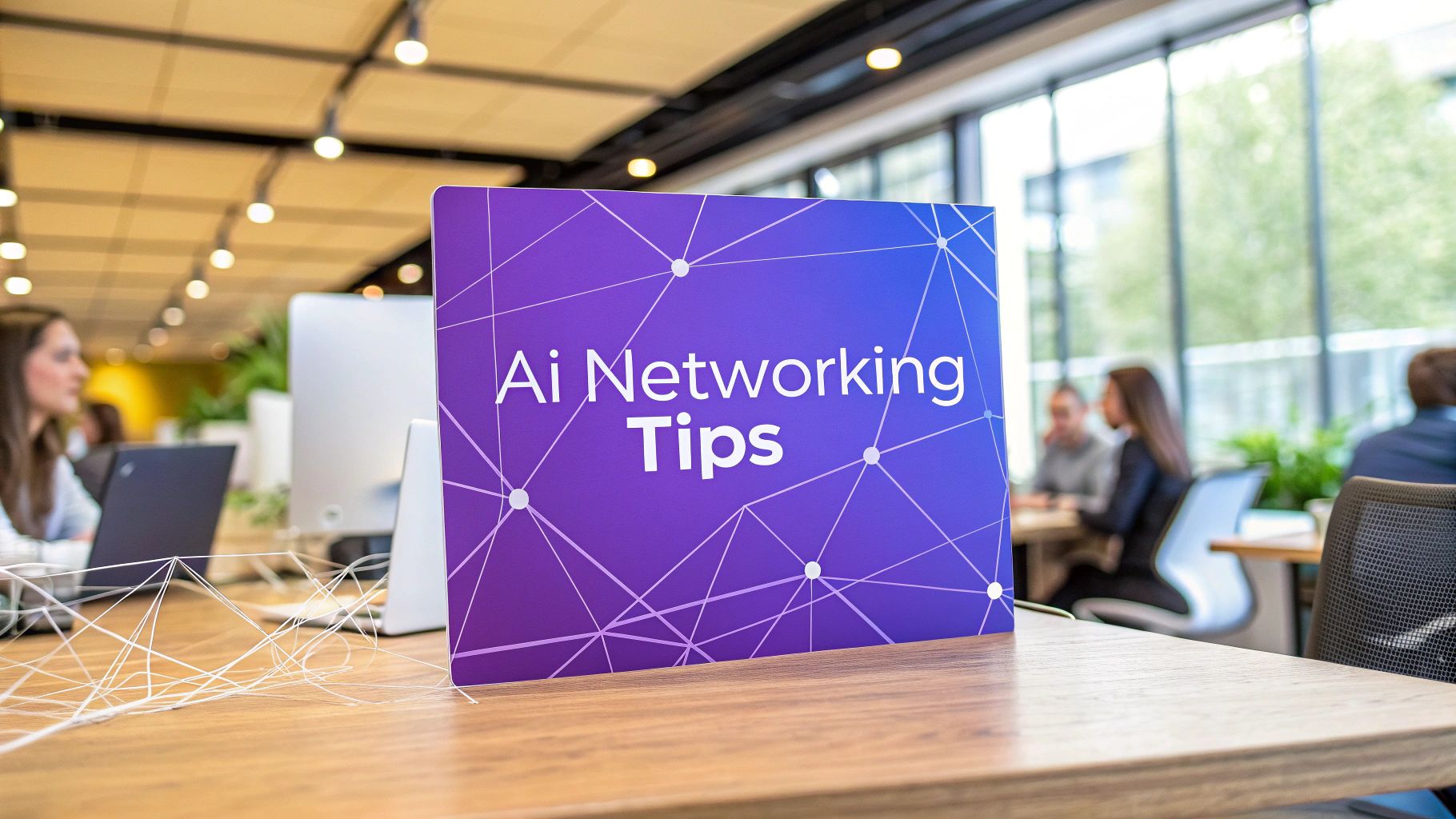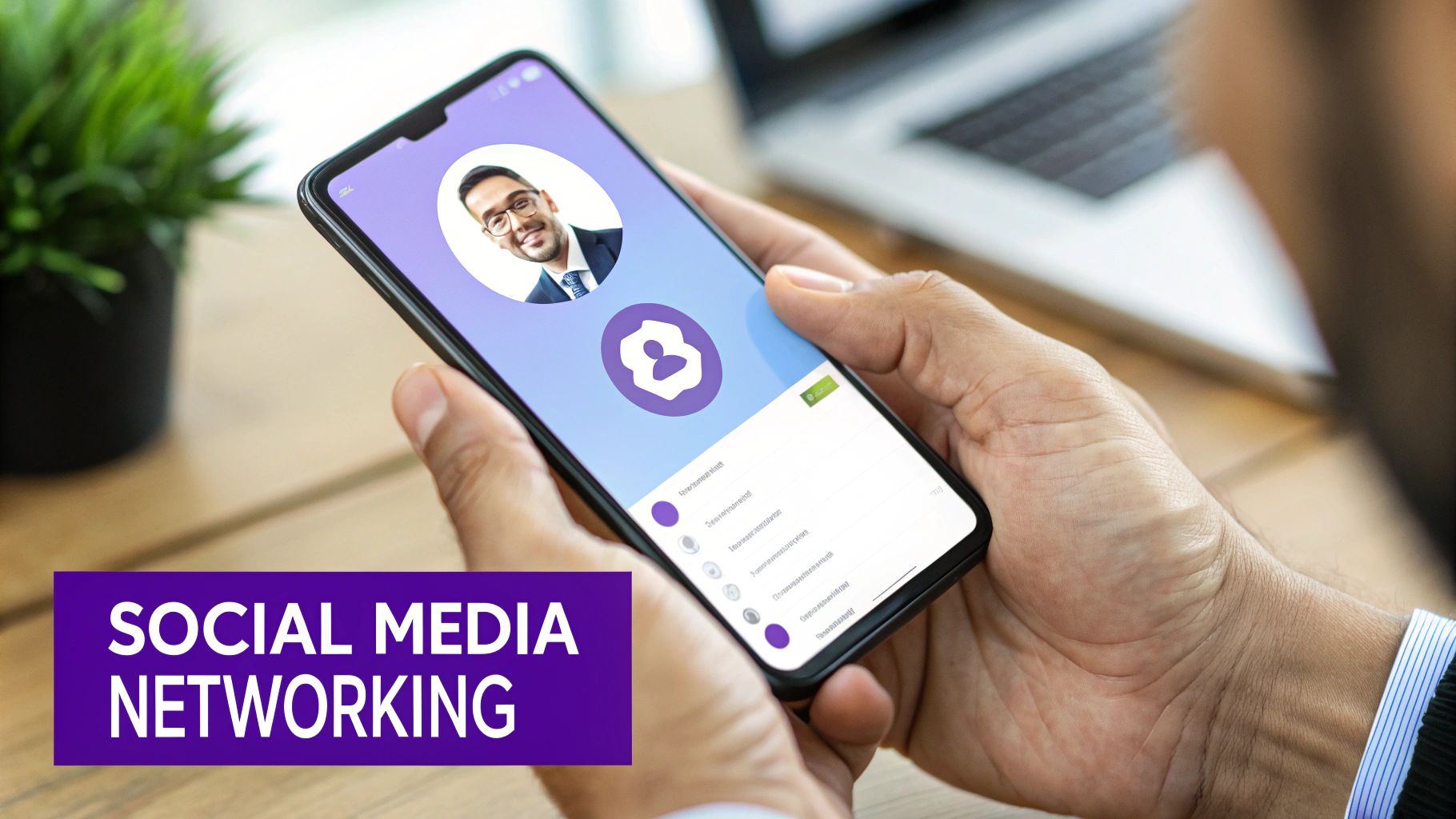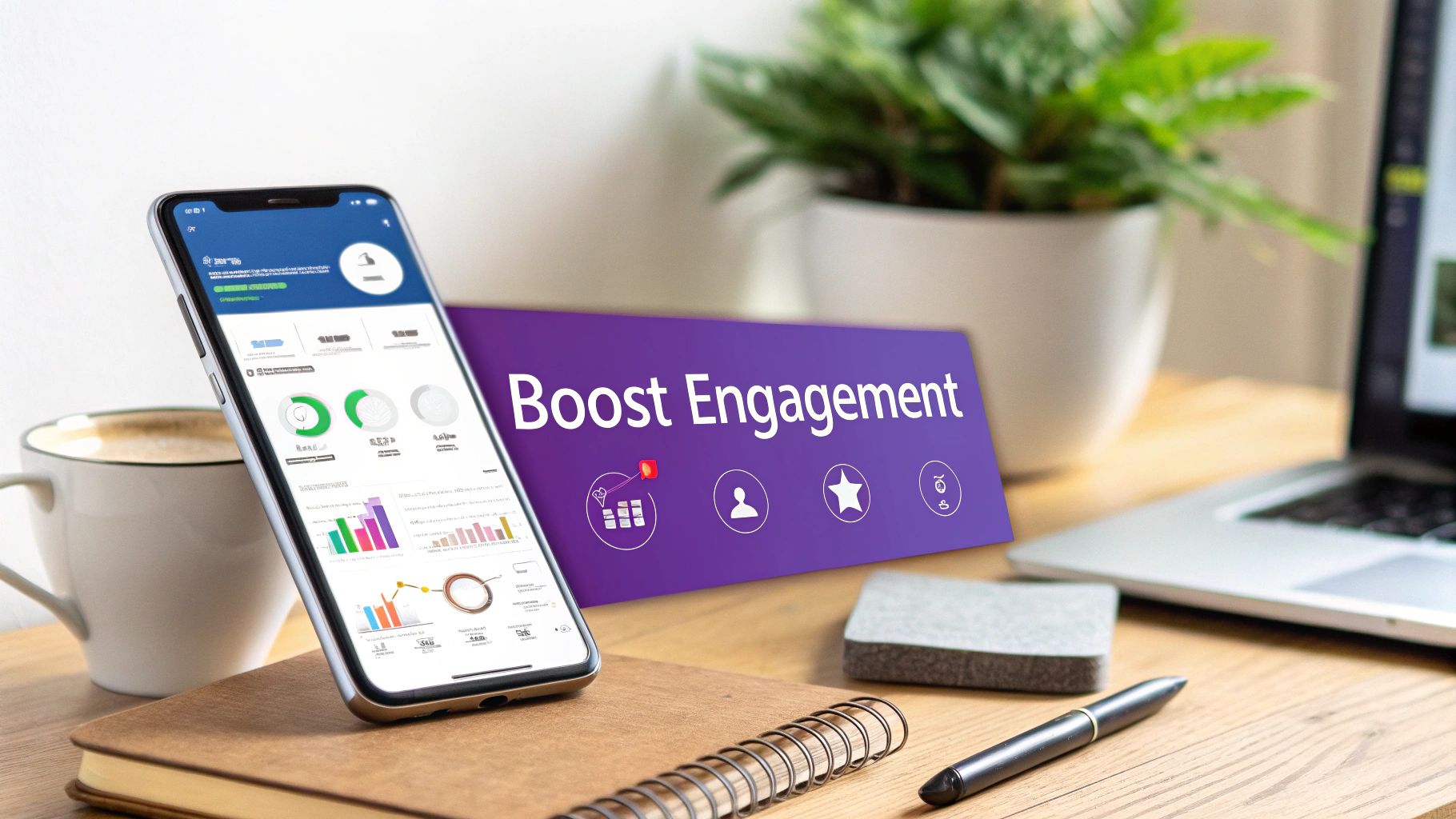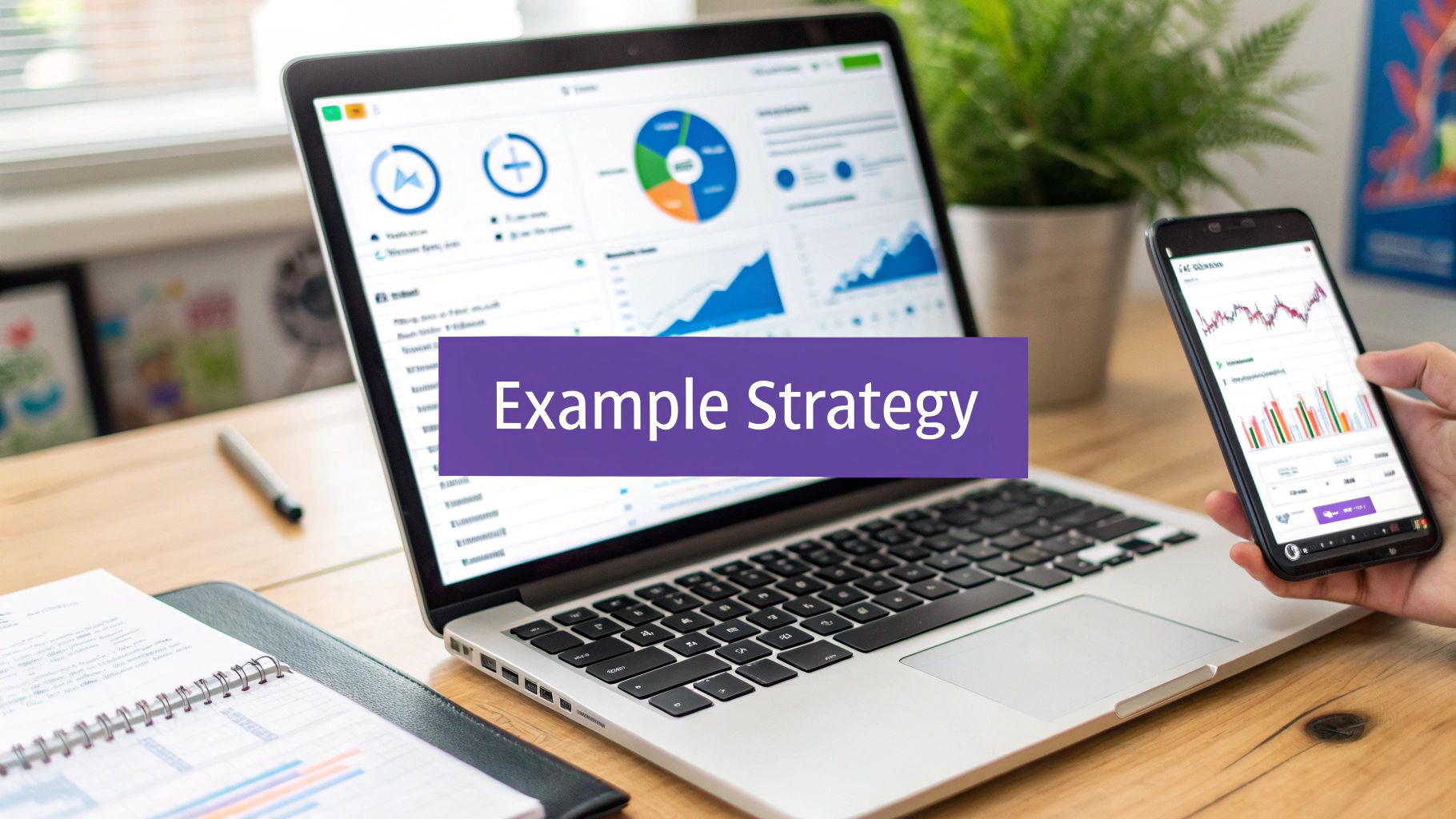8 AI-Powered Professional Networking Tips for 2025

Professional networking has evolved far beyond exchanging business cards at crowded events. To build meaningful connections that translate into real opportunities, your approach must be smarter, more targeted, and significantly more efficient. This is where artificial intelligence becomes your most valuable asset. While foundational advice like building relationships and following up remains crucial, integrating AI tools can amplify every aspect of your strategy, from your initial outreach to nurturing long-term professional bonds.
This guide provides 8 powerful, AI-enhanced professional networking tips designed to help you navigate the modern professional landscape with confidence. We will move beyond generic recommendations to deliver actionable frameworks for everything from strategic social media engagement to mastering internal networking. You'll learn how to optimize your digital first impression, build relationships at scale, and ensure every connection you make is a quality one. To truly leverage technology in your networking efforts, you can explore how to implement AI-powered cold outreach strategies to connect with key contacts more effectively. By the end of this article, you will have a clear roadmap for transforming your networking from a time-consuming task into a powerful engine for career growth.
1. Build Relationships Before You Need Them
The most impactful professional networking tip is also the most proactive: build your network before you need it. This foundational principle, championed by figures like Keith Ferrazzi and Reid Hoffman, shifts networking from a transactional, last-minute activity to a long-term strategy of genuine relationship-building. Instead of scrambling for contacts when you're looking for a job or funding, you cultivate a robust network of trusted allies who are already invested in your success.

This approach focuses on creating mutual value and trust over time. Think of it as making deposits into a "relationship bank." When you consistently offer help, share valuable insights, and engage with your contacts during stable periods, you build significant relational capital. Later, when you need to make a "withdrawal" by asking for an introduction, advice, or a referral, the request is received as a natural part of a strong, established connection, not a desperate plea.
How to Implement This Strategy
- Schedule dedicated networking time: Block out 30-60 minutes each week specifically for relationship maintenance. This could involve commenting on LinkedIn posts, sending personalized check-in messages, or sharing a relevant article with a contact.
- Focus on giving, not taking: Your primary goal should be to help others. Share opportunities, offer your expertise without expectation, and make valuable introductions for your connections. This generosity is the cornerstone of powerful networking.
- Leverage a "personal CRM": Use tools like a simple spreadsheet, Notion, or a dedicated CRM to track key details about your contacts. Note their professional interests, personal milestones, and recent conversations to make your future interactions more meaningful and personalized.
- Engage with content: Don't just be a passive observer. Actively like, comment on, and share the content posted by people in your network. This simple act keeps you visible and demonstrates your engagement with their work and ideas.
2. Master the Art of the Informational Interview
One of the most underutilized yet effective professional networking tips is mastering the informational interview. This strategy, popularized by career experts like Richard Bolles, involves reaching out to professionals not to ask for a job, but to ask for advice and insight. It reframes the interaction from a high-pressure pitch to a low-stakes conversation, allowing you to build genuine connections while gathering invaluable firsthand knowledge about a role, company, or industry.

The core principle is curiosity. Whether you are a career changer exploring a new field or a recent graduate mapping out potential paths, these brief interviews provide a direct line to the realities of a profession. You gain unfiltered perspectives on daily responsibilities, required skills, and industry trends, which is far more powerful than what you can find in a job description. This approach respects the professional's time and expertise, often making them more willing to help and remember you favorably.
How to Implement This Strategy
- Do your homework: Before reaching out, thoroughly research the person and their company. Understand their career trajectory, recent projects, and contributions. This allows you to ask specific, intelligent questions that demonstrate genuine interest.
- Keep the request concise: When you reach out, be direct and respectful of their time. Clearly state that you are seeking advice, not a job, and ask for just 15-20 minutes. This significantly increases your chances of getting a "yes."
- Prepare thoughtful questions: Develop 5-7 open-ended questions focused on their experience. Ask about their biggest challenges, what a typical day looks like, or what advice they would give someone starting in their field.
- End with a strategic question: Conclude the conversation by asking, "Based on our conversation, is there anyone else you would recommend I speak with?" This question is a powerful tool for expanding your network organically. Always follow up with a personalized thank-you note within 24 hours.
3. Strategic Social Media Networking
In today's digital-first world, your online presence is an essential extension of your professional identity. Strategic social media networking moves beyond passively having a profile; it involves actively using platforms like LinkedIn, Twitter, and even industry-specific forums to build your brand, share expertise, and forge meaningful connections. This approach, exemplified by entrepreneurs like Gary Vaynerchuk, transforms social platforms from simple directories into dynamic spaces for relationship-building and opportunity creation.

This method isn't about collecting thousands of superficial connections. Instead, it’s about curating a relevant audience and engaging in authentic conversations that establish you as a knowledgeable and approachable figure in your field. By consistently providing value through insightful content and thoughtful interaction, you attract like-minded professionals, recruiters, and potential clients, effectively expanding your network far beyond geographical limits. This makes it one of the most scalable and impactful professional networking tips for the modern era.
How to Implement This Strategy
- Optimize your digital storefront: Your LinkedIn profile is your digital business card. Ensure it is complete with a professional headline, a compelling summary, and detailed experience. For strategic social media networking, especially on platforms like LinkedIn, your profile picture serves as your crucial digital handshake, and you can find comprehensive guidance on optimizing your LinkedIn profile picture to make the best first impression.
- Share value, not just updates: Focus your content on helping your audience solve problems or understand industry trends. Share articles, create short analyses, or post helpful tips. This positions you as a thought leader rather than just a self-promoter.
- Engage with intention: Don’t just "like" posts. Leave thoughtful, substantive comments on others' content to start conversations. Participate in relevant Twitter chats or LinkedIn group discussions to increase your visibility and connect with active professionals.
- Personalize your outreach: When sending a connection request, always include a personalized note. Reference a shared connection, a recent post they wrote, or your interest in their company to show you’ve done your homework and are genuinely interested in connecting.
4. The Follow-Up Framework
Making a great first impression is only half the battle; the real value in networking lies in nurturing that initial connection. This is where a systematic follow-up framework becomes essential. Popularized by experts like Harvey Mackay, this approach transforms a fleeting interaction into a durable professional relationship through timely, valuable, and consistent communication. It’s the process that ensures your efforts at conferences, meetings, or online events don't fade into memory.

The core idea is to move beyond a single, generic "nice to meet you" email and adopt a structured sequence of touchpoints. By doing so, you remain top-of-mind and demonstrate genuine interest and professionalism. This method is a cornerstone of effective professional networking tips because it provides a reliable system for building rapport, whether you're a job seeker hoping for a future referral or an entrepreneur cultivating a relationship with a potential investor.
How to Implement This Strategy
- Act within 24-48 hours: Send your initial follow-up message while the conversation is still fresh. This immediate action shows you're organized, attentive, and serious about the connection.
- Personalize and add value: Your message should reference a specific point from your conversation to jog their memory. Go a step further by including a relevant article, a useful tool, or an introduction that aligns with their interests.
- Establish a follow-up cadence: Don't let the conversation die. Plan to check in at strategic intervals, such as 1, 3, and 6 months. A simple "I saw this and thought of you" message can be incredibly powerful for maintaining the relationship.
- Use a system to stay organized: Implement a "personal CRM" using a spreadsheet or a tool like Notion to track your interactions, set reminders for your next follow-up, and note key details about your contacts. This prevents valuable connections from falling through the cracks.
5. Quality Over Quantity Networking
In a world obsessed with follower counts and connection numbers, one of the most powerful professional networking tips is to pivot your focus from quantity to quality. This strategy, underscored by research from thought leaders like Adam Grant, argues that a smaller, more engaged network of deep relationships is far more valuable than a vast collection of superficial connections. Instead of chasing a high connection count, you concentrate on building trust and mutual understanding with a select group.
This approach transforms networking from a numbers game into a strategic investment in people. Consider the difference between having 5,000 LinkedIn connections who barely know your name and 50 key contacts who would readily vouch for your skills, introduce you to their network, or collaborate on a project. Senior executives often exemplify this, maintaining close ties with board members and peers, while specialized consultants build deep, lasting relationships within specific industry niches. These strong bonds provide substantial, long-term value.
How to Implement This Strategy
- Identify your core network: Start by listing 20-50 key individuals who are most critical to your professional growth. These could be mentors, industry peers, former colleagues, or high-potential new contacts. This focus ensures your energy is well-spent.
- Schedule dedicated one-on-ones: Proactively schedule brief virtual or in-person meetings with your priority contacts. The goal is to maintain a genuine, ongoing dialogue, not just to reach out when you need something.
- Remember the details: Pay close attention to both professional and personal milestones. Acknowledge a work anniversary, ask about a project they mentioned, or congratulate them on a personal achievement. This demonstrates authentic interest.
- Offer substantial, proactive help: Go beyond simple "likes" and shares. Connect them with a resource you know they'll value, offer your expertise on a challenge they're facing, or make a high-value introduction. This deepens the reciprocity of the relationship.
6. Give First Networking Philosophy
The "Give First" philosophy is a powerful professional networking tip that flips the traditional script on its head. Instead of approaching networking with a "what can I get?" mindset, you lead with "what can I give?" This approach, championed by thought leaders like Adam Grant and Brad Feld, focuses on generously offering value, help, and resources to others without any immediate expectation of reciprocity. It's about building a reputation as a helpful, resourceful, and trustworthy individual.
This strategy cultivates deep goodwill and establishes your credibility long before you ever need to ask for a favor. When you consistently provide value, you create a network of people who are not just connected to you, but are genuinely invested in your success and eager to help you when the time comes. This transforms networking from a transactional exchange into a community-building exercise, creating a powerful foundation for reciprocal, long-term relationships.
How to Implement This Strategy
- Offer your expertise freely: Share your knowledge and skills to help others solve a problem. This could be a quick 15-minute consultation on a topic you excel at or offering feedback on a project.
- Be a strategic connector: Think about who in your network could benefit from knowing each other and make a thoughtful, double-opt-in introduction. Facilitating valuable connections for others is one of the most powerful ways to give.
- Share valuable resources: When you come across an article, a job opportunity, or a tool that you think someone in your network would find useful, share it with them. This simple act shows you're thinking of them and their goals.
- Provide testimonials and recommendations: Publicly endorse the skills and accomplishments of your contacts on platforms like LinkedIn. A genuine recommendation is a significant and highly visible form of giving.
7. Strategic Event Networking
Attending conferences, meetups, and industry gatherings without a plan is a common mistake that yields few results. Strategic event networking transforms these opportunities from passive experiences into highly productive missions. This systematic approach involves pre-event planning, focused in-person engagement, and diligent follow-up to build meaningful professional relationships, not just collect business cards.
This method, championed by event platforms like Bizzabo and Whova, emphasizes quality over quantity. Instead of aimlessly wandering the event floor, you arrive with clear objectives, a list of target individuals, and conversation starters. This preparation allows you to navigate crowded rooms with purpose, whether you're a tech professional at CES seeking innovators or an entrepreneur at an industry summit looking for partners. The goal is to create memorable interactions that form a strong foundation for future collaboration.
How to Implement This Strategy
- Conduct Pre-Event Reconnaissance: Before the event, review the attendee and speaker lists. Identify 5-10 key individuals you want to connect with, research their work, and find common ground. This homework makes your initial approach feel informed and genuine.
- Set Specific, Measurable Goals: Define what success looks like. Your goal might be to "have three meaningful conversations with potential mentors" or "connect with two hiring managers from target companies." Clear goals guide your actions and prevent wasted time.
- Prioritize Smaller, Focused Sessions: Large keynotes are great for learning but poor for networking. Attend smaller breakout sessions, workshops, or roundtable discussions. The intimate setting makes it far easier to engage in substantive conversations and connect with speakers and fellow attendees. To truly maximize your impact at gatherings, consider these insightful advanced conference networking tips.
- Execute a Prompt Follow-Up Plan: The connection is made after the event. Within 48 hours, send a personalized follow-up message on LinkedIn or via email. Reference a specific point from your conversation to jog their memory, reiterate any value you offered, and suggest a clear next step.
8. Internal Networking and Relationship Building
Some of the most powerful professional networking tips focus not on external connections, but on those within your own organization. Building strong internal relationships is a strategic way to increase your visibility, influence, and access to hidden opportunities. This approach, often championed by organizational development experts and corporate career coaches, transforms your workplace from just a place you work into a dynamic ecosystem for career growth.
By developing connections across different departments, seniority levels, and even global offices, you create a robust support system. This network can provide crucial project support, advocate for your ideas, and alert you to internal job openings before they are widely advertised. A manager who cultivates relationships with senior leadership is better positioned for mentorship and advancement, just as an employee who befriends colleagues in other departments may receive a coveted internal referral. It’s about building influence and allies who can champion your career from within.
How to Implement This Strategy
- Schedule purposeful coffee chats: Intentionally reach out to colleagues in different departments for brief, informal 15-30 minute virtual or in-person meetings. Ask about their roles, challenges, and projects to build rapport and understand the wider business.
- Join cross-functional committees: Volunteer for company-wide initiatives, task forces, or social committees. This provides natural, low-pressure opportunities to work alongside and build relationships with influential people from across the organization.
- Offer your expertise freely: Be the person who is known for being helpful. If you have a skill that can unblock a colleague's project, offer your assistance without expecting anything in return. This builds a reputation as a valuable and collaborative team player.
- Participate in mentorship programs: Actively seek out or become a mentor through your company’s formal programs. These structured relationships are an excellent way to connect with both senior leaders and rising talent, expanding your internal network in a meaningful way.
Professional Networking Tips Comparison Table
| Networking Strategy | 🔄 Implementation Complexity | 💡 Resource Requirements | 📊 Expected Outcomes | ⚡ Ideal Use Cases | ⭐ Key Advantages |
|---|---|---|---|---|---|
| Build Relationships Before You Need Them | Medium to High: Requires ongoing effort | High: Time and consistent engagement | Strong, authentic networks with lasting trust | Long-term career growth, startup founders | Creates lasting trust and opens unexpected doors |
| The Power of Informational Interviews | Medium: Needs preparation and scheduling | Medium: Time for research and meetings | Insider knowledge, expanded network, career insights | Career changers, students, job seekers | Low-pressure learning and mentoring opportunities |
| Strategic Social Media Networking | Medium: Requires consistent digital activity | Medium: Time and content creation tools | Global reach, thought leadership, asynchronous engagement | Professionals building brand and wide networks | Cost-effective global networking and engagement |
| The Follow-Up Framework | Medium: Systematic and disciplined process | Medium: CRM tools and messaging time | Stronger relationships, increased memorability | Sales professionals, job seekers, entrepreneurs | Converts contacts into lasting relationships |
| Quality Over Quantity Networking | Medium: Focused and selective effort | Medium: Time per relationship | Deeper, more meaningful professional connections | Executives, consultants, close-knit industries | Stronger, trusted connections with less maintenance |
| Give First Networking Philosophy | Medium to High: Requires generosity and time | High: Significant time and resource input | Builds goodwill, strong reciprocal relationships | Mentors, startup communities, generous networkers | Establishes credibility and natural reciprocity |
| Strategic Event Networking | High: Involves planning, execution, follow-up | High: Time, travel, event participation | Multiple concentrated connections, face-to-face impact | Conference attendees, industry event participants | Maximizes event networking opportunities |
| Internal Networking and Relationship Building | Medium: Requires political savvy and persistence | Medium: Time and relationship management | Increased visibility and career advancement support | Corporate employees seeking growth internally | Builds influence and collaboration within organizations |
Start Building Smarter Connections Today
The journey through the modern landscape of professional networking reveals a powerful truth: success is no longer a matter of chance encounters but of deliberate, strategic relationship architecture. We’ve moved beyond simply collecting contacts; the goal now is to cultivate a vibrant ecosystem of mutually beneficial connections. By integrating the actionable strategies discussed, you can transform your approach from passive to proactive, ensuring every interaction holds the potential for significant growth.
Recapping Your Networking Blueprint
Throughout this guide, we've unpacked a series of powerful professional networking tips designed for immediate impact. Let's revisit the core pillars you can start building upon today:
- Proactive Relationship Building: The principle of building your network before you need it is your greatest insurance policy against career uncertainty.
- Strategic Inquiry: Leveraging informational interviews turns a simple conversation into a potent source of industry insight and authentic connection.
- Digital Diligence: Mastering strategic social media engagement and a consistent follow-up framework ensures your digital presence works for you 24/7.
- Targeted Connection: Prioritizing quality over quantity and adopting a "give first" philosophy will build you a reputation as a valuable, sought-after collaborator.
- In-Person and Internal Impact: Actively engaging at events and nurturing relationships within your own organization creates a robust, 360-degree support system.
From Knowledge to Action: Your Next Steps
Mastering these concepts is not just about expanding your contact list. It's about unlocking doors to unadvertised opportunities, gaining access to invaluable mentorship, and positioning yourself as a key player in your field. The true value lies in the sustained momentum you create. A strong network acts as a career accelerator, providing support during transitions, inspiration for new ventures, and the collaborative energy needed to bring ambitious ideas to life.
Your task now is to transition from learning to doing. Don't feel pressured to implement every tip at once. Instead, choose one or two strategies that resonate most with your current goals.
- Select a Focus Area: Is your immediate goal to land a new role? Start with informational interviews. Are you looking to establish yourself as an expert? Double down on strategic social media networking.
- Set a Small, Measurable Goal: Commit to sending three personalized connection requests on LinkedIn this week or scheduling one informational interview this month.
- Track and Iterate: Pay attention to what works. Did a particular type of follow-up message get a better response? Refine your approach based on real-world feedback.
Ultimately, the most effective professional networking tips are the ones you consistently practice. By weaving these habits into your professional life, you are not just networking; you are investing in the long-term health and dynamism of your career. The connections you build today are the foundation for the opportunities you will seize tomorrow.
Ready to supercharge your online presence and make every connection count? MakerBox provides a suite of AI-powered tools designed to optimize your professional profiles and automate outreach, helping you implement these networking strategies with greater efficiency. Visit MakerBox to see how you can build a more powerful professional brand in minutes.





